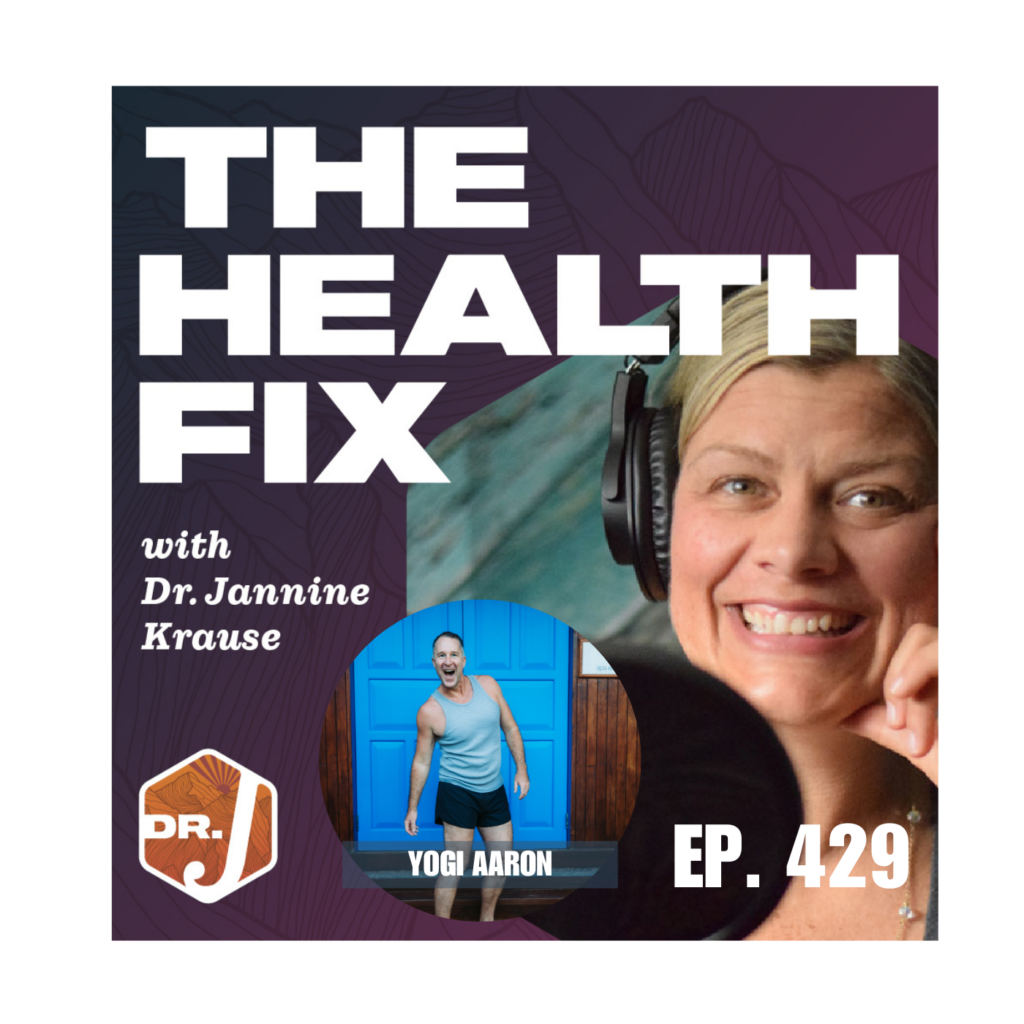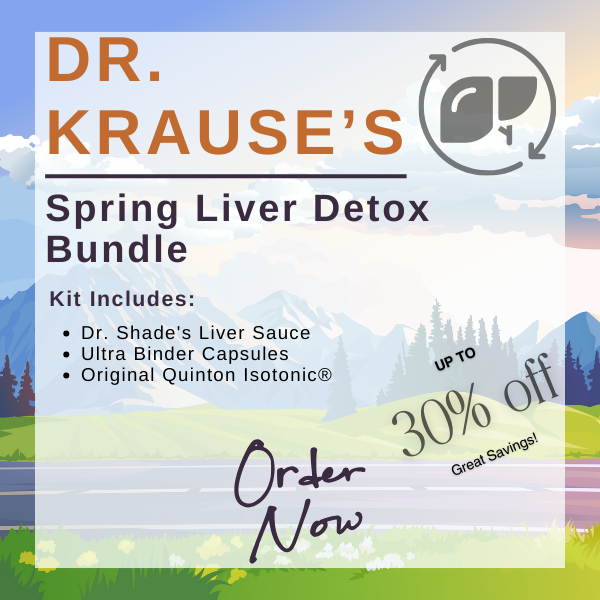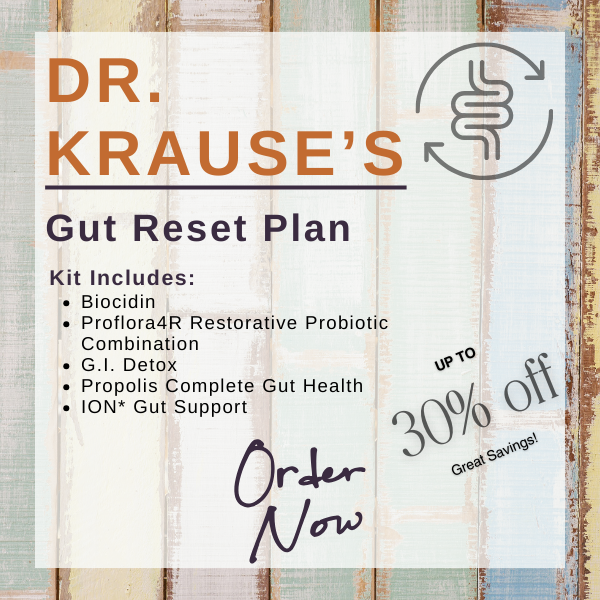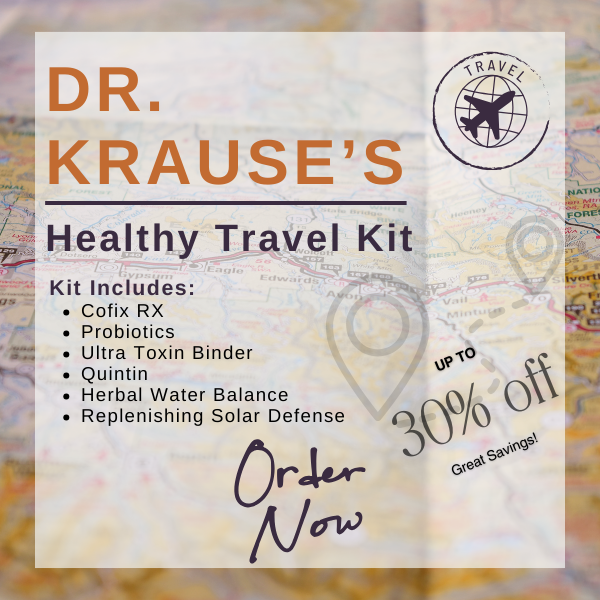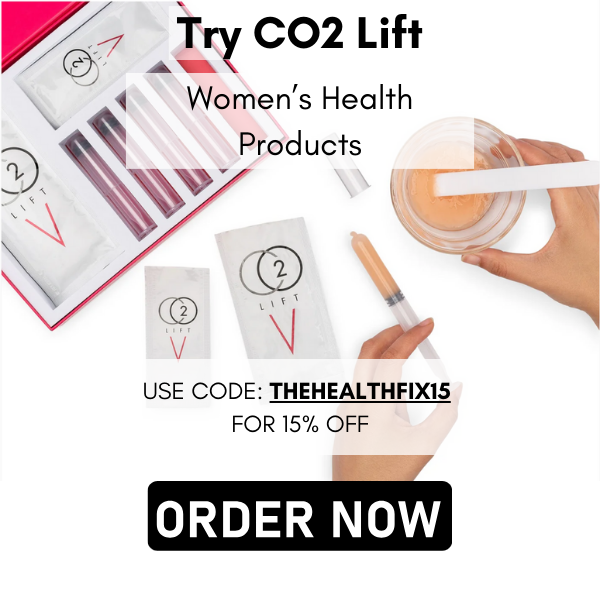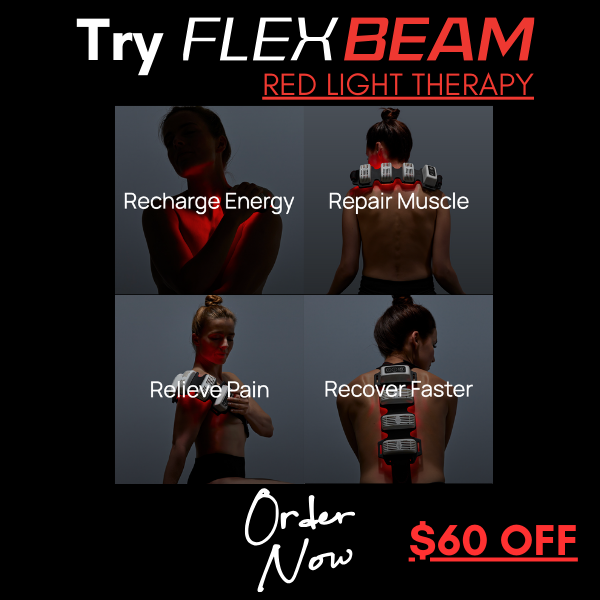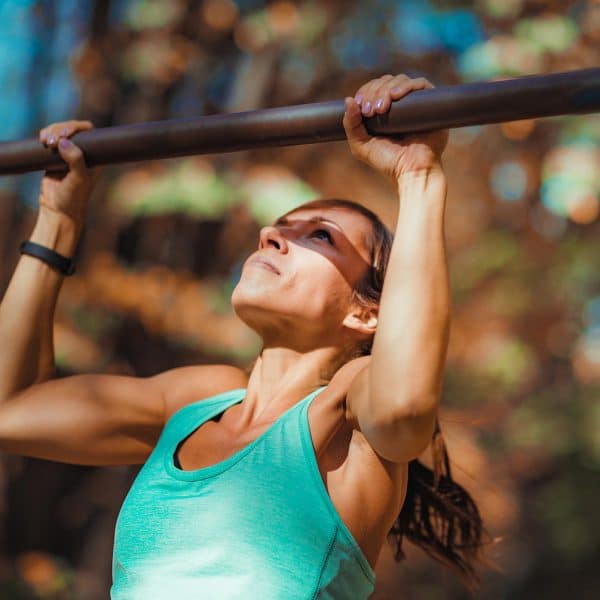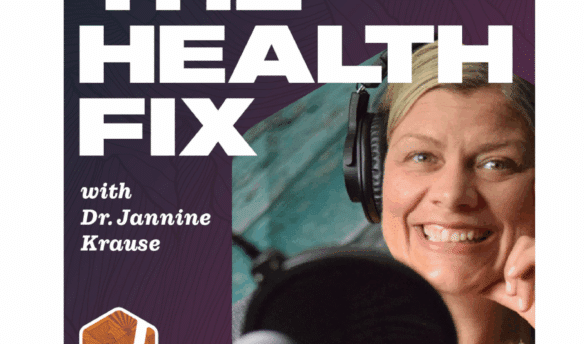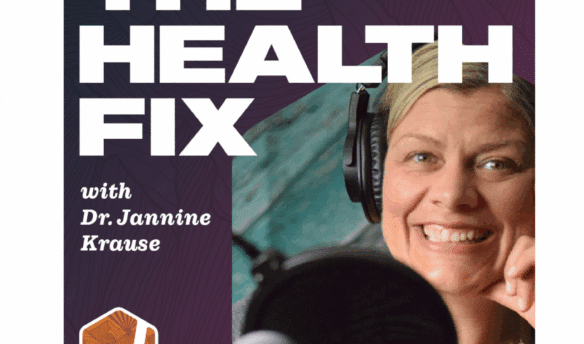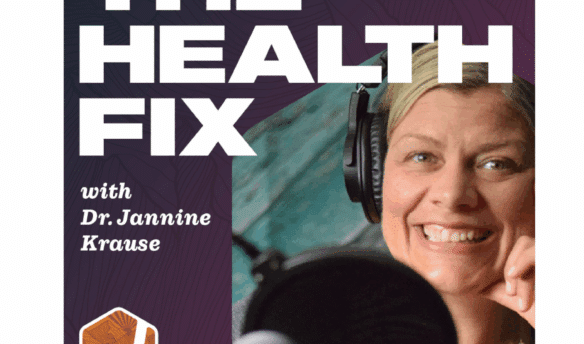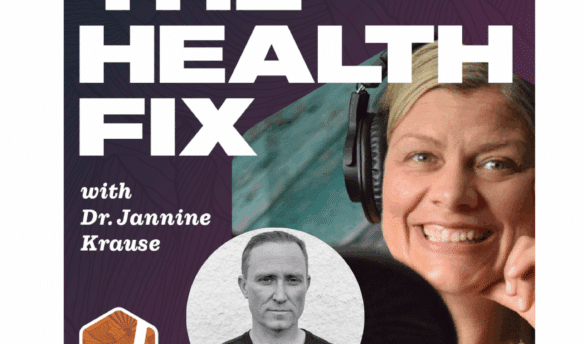Got tight muscles that never seem to relax? Aches and pains that nothing seems to help permanently? Yogi Aaron was a master yogi yet he struggled with chronic low back pain. After a consult with a surgeon for a spinal fusion he knew there had to something he could do to avoid surgery besides stretching and flexibility practices. Yogi Aaron personal journey transformed him into a trailblazing yoga teacher who is leading a global rebellion against the harmful practice of stretching. He pioneered the groundbreaking approach to yoga that shows people how to live pain-free by activating muscles through Applied Yoga Anatomy + Muscle Activation™ (AYAMA). In this episode of The Health Fix Podcast, Dr. Jannine Krause interviews Yogi Aaron on his unorthodox method of mixing yoga and muscle activation to help people get rid of their pain for good.
Dr. Krause’s Protocols
Instructions Included
Traveling soon? Looking to detox or reset your gut? Try one of Dr. Krause’s Fullscript plans.
What You’ll Learn In This Episode:
- Which yoga poses weaken muscles while others strengthen them
- How to pair muscle activation technique with yoga
- Why yoga is about stability NOT flexibility
- How flexibility leads to instability and injuries
- Why supporting your body’s stability promotes better mobility
- How a stable body promotes a calm mind
- Why hot yoga isn’t all it’s cracked up to be
Resources From The Show:
Our Partners
Podcast Transcript:
Summary
2:18 – Yogi Aarons story
5:20 – Why Yogi Aaron?
8:25 – Yoga’s dirty little secret
9:09 – How flexible do you need to be for yoga
13:06 – Why the body protects itself while stretching
14:49 – Importance of muscle activation
15:31 – Why stretching can be bad
17:16 – How muscle contractions work
18:10 – How to reprogram a muscle
19:03 – Muscle activation
19:39 – Difference between weak and strong muscle
23:42 – Reactivating the psoas muscle
25:53 – What does a yoga session look like?
27:29 – Number one pose to stay away from
28:13 – Aaron’s favorite two poses
30:41 – Why stability is important in yoga
32:33 – Is alignment important?
38:09 – Is yaga all about stretching and flexibility?
38:30 – The ultimate goal of yoga
44:05 – Are gymnasts good at yoga?
45:22 – Importance of stability of mind/body
47:24 – Aarons take on hot yoga
55:12 – How to get in touch with Yogi Aaron
JANNINE: [Intro ]Welcome to the Health Fix Podcast, where health junkies get their weekly
fix of tips, tools and techniques to have limitless energy, sharp minds and fit
physiques for life.
Hey health junkies, on this episode of the Health Fix Podcast, I’m interviewing
Yogi Aaron. He is a trailblazing yoga teacher who’s on a serious mission and
rebellion against stretching. He pioneered the groundbreaking approach to yoga that
that shows people how to live pain free by activating muscles through applied yoga anatomy
and muscle activation, which he calls Ayama. So in a world where stretching and flexibility are
kind of what’s recommended all the time when there’s pain, Yogi Aaron’s fighting the curve
there. He is going to tell us a ton about why stretching and certain yoga practices are not
what we want to be doing. And I gotta say, his stuff makes a lot of sense, especially based on my
research into the body and even going into some of my advanced training with acupuncture and things
of that nature. So Yogi Aaron is on a mission. He’s a great wealth of knowledge. And I really
look forward to you guys here in this podcast. So let’s introduce you to Yogi Aaron. Hey health
– Well, junkies, I have Yogi Aaron on today,
and we’re going to be talking about a lot of things
alternative health, but in particular,
we’re gonna be talking about stretching.
And why I have told folks over and over again,
stop stretching so much, we might have some problems.
And so Yogi, Erin’s gonna tell us,
gonna tell us, you know, why that could be detrimental
to our health and overall longevity of our muscles and such.
So, Yogi, Aaron, welcome to the Health Fix Podcast.
AARON: Thank you so much for having me on Dr. I appreciate it.
JANNINE: No problem, no problem.
So as we were jumping on the call,
we were talking about all the lovely things
you had mentioned that you are in Costa Rica.
So I wanna give folks a little bit of a scoop of like,
you were saying you have a retreat center
and you’re down there.
How did you come to find Costa Rica?
What’s your story about how you landed in Costa Rica?
Give us the scoop.
AARON: So I’m a yoga teacher by trade,
and I started leading yoga retreats around the world.
And after leading a yoga retreat in Hawaii,
a lot of my students were based in New York.
A student suggested that I go to Costa Rica.
So I came down here in January of 2004
on a scouting trip and just fell in love with Costa Rica.
There’s much like Hawaii has that Aloha spirit,
Costa Ricans have this Perovita spirit,
which is very similar to the same kind of ideas Aloha,
but this place is just so chocked full of life,
different species of birds and monkeys,
where my place is on the Osa Peninsula,
there’s, sometimes we have four species of monkeys,
like circling around our property.
I don’t say circling in a bad way, by the way.
(laughs)
JANNINE: Yes, yes.
AARON: It’s not a planet of the ape sort of thing, but also, you know, the Osa Peninsula, which
is where we’re located, has been said to hold 2.5% of the Earth’s biodiversity in this
small, tiny place, like really tiny place.
So it’s just a very majestic place.
I fell in love with it.
And about three years later, on another trip, I, there was this, passed this property with
the century 21 sign outside.
And as I looked through,
there was this tunnel of boganvelias and hibiscus flowers.
And as I looked through this tunnel,
at the end of it was this crystal clear turquoise blue sea
and I just felt like that was home to me.
So that’s what led me there.
JANNINE: Wow.
I would like a tunnel boganvelias and hibiscus.
That sounds amazing to have like the,
– Just through the tunnel and then you see the ocean.
My goodness, sounds super peaceful.
Now of course I gotta ask,
Oso is the name for bear, right?
It’s Spanish and so it’s on the beach now.
AARON: That’s correct, well done, yes.
JANNINE: Are there bears out there?
AARON: To my knowledge, there has never been bears
on the Oso Peninsula.
I don’t know why, and I’m probably making this up,
but maybe there’s some truth to this,
that there was some sort of native tribe there in the past
that was like the OSA tribe.
Again, I don’t really know for sure.
So I’m probably talking a little out of school.
(laughs)
JANNINE: No worries, I’m going like, man,
I don’t know about bears living south of the equator area.
I don’t know.
AARON: Yeah.
JANNINE: And I’m like, I don’t even know
where the equator is in my brain right now.
So anyway, I might be talking out of school,
but the interesting about the name,
I always wonder about names.
I’m like, did it look like a bear?
Does it come from above?
So, anyway, so tell us a little bit about
how you came to be Yogi, Aaron.
Like what inspired you with yoga?
How did you come to Yogi?
What’s your story there?
AARON: Well, Yogi, Aaron, so my name is Aaron,
and then Yogi is sort of like a title, a nickname, if you will.
And it just kind of denotes this idea.
It reinforces this idea that I am a person
that practices yoga.
I started yoga when I was about 18 years old and very quickly and like most people who
get into yoga, I did it for two reasons, to stay young and to keep the mobility in my
body, to stretch, to get rid of tightness.
The interesting thing was very shortly after me starting to stretch, a.k.a. do yoga or
a.k.
stretch, that I hurt myself really badly in my back.
I remember that my lower back completely seized up on me,
and I was having the thought of like,
I, this is not how I want to live my best life.
(laughs)
And so I, the solution was, was to stretch more.
And every time I went to a yoga teacher,
I would tell them of my back problems.
I became a person who had back problems.
And they would just say to me, we need to open your hips.
We need to open your hamstrings.
we need to open your lower back.
So of course the solution was to stretch
and every morning I remember getting out of bed
feeling, oh my God, my body feels like 100 years old.
I, okay, well, let’s go bang out of practice.
Let’s go and stretch.
And I would always feel better.
Like there was no doubt that I would feel better,
but then the tightness came back with the vengeance.
The problems came back with a vengeance.
And about 25 years after doing this,
I ended up in the emergency room of a hospital
with the orthopedic surgeon telling me
that I was gonna need a spinal fusion
probably in my lower back.
And that was like a moment of reckoning
when I kind of realized I needed to go back to basics
and understand the body.
And that whole journey kind of led me
into muscle activation technique
and where I studied how to activate muscles
and understanding the causes of why muscles
are tight in the first place.
And that kind of took me into this whole practice
of teaching applied yoga anatomy and muscle activation.
JANNINE: Yeah, you know, that whole concept there of,
you know, most people look at someone who’s a yogi, right?
And they’re like, they must be so flexible.
And, you know, that’s the way we need to get into.
And a lot of folks are, why don’t you try yoga?
But hearing that you were like set for a spinal fusion,
a lot of people would be like,
but you were doing yoga.
You know, and that’s where a lot of people would be thinking,
like, are you sure you weren’t like power lifting,
you weren’t on the side, you know, working, you know,
lifting heavy weights in the oil field?
Like, you know, folks would be thinking like,
was there anything else that could have possibly contributed
to this?
AARON: Sure.
Well, I want to just comment and say that one of the dirty secrets, I think it’s a dirty secret
in the yoga world that very few people talk about, is how many, especially senior yoga teachers
have had knee replacements, hip replacements, lower back surgeries, shoulder surgeries.
like there’s a lot of yoga teachers, yoga people who have really, really bad bodies for lack of
better words and have needed surgical intervention. And so a lot of there’s been this kind of
idea that, oh, to be a yoga person, we need to be more flexible and to be a good yoga person,
and I need to be more flexible.
And the irony of it, to me sometimes,
is that a lot of yoga teachers, most yoga teachers,
will say, well, yoga isn’t about flexibility.
Meanwhile, they’re saying that as their foot
is wrapped around their head, you know?
And it’s such a, it’s kind of a hypocritical thing
to say one thing, but then do another thing.
and it sends a very mixed message to the students.
How can I, if you’re putting your foot behind your head,
therefore on the student,
I should be putting my foot behind my head.
I need to be more flexible.
And it’s like yoga has nothing to do with flexibility
or stretching.
And one of the things that my teacher Greg always says
is that you can become more flexible,
but flexibility always leads to instability
and instability always leads to injury.
So if you want to stretch, you know, namaste,
but you are going to end up injured, you know,
either in the near future or distant future,
you will end up injured.
And possibly you might need, you know,
surgical intervention.
JANNINE: Yeah, you know, and you bring this up, you know,
I wanted you to kind of share that too,
because one of the things I see as an acupuncturist
is I have a lot of yogis that show up in my office
and they’re like, yeah, I’ve got this elbow thing,
I can’t seem to get rid of it, I’d have to shoulder thing.
And so I always was like, if, okay,
you know, there’s that like thought process,
like if you’re getting banged up all the time
and you’re not, you know, but you’re not doing what,
you know, you’re doing what we’ve been all told to do,
it’s really confusing and also hard for a doc to be like,
okay, I think you could benefit from the mind stuff of yoga,
you know, and, but, but maybe yoga isn’t for you in that type, right?
In that sense of like stretch and I’ll explain something.
Um, when I’d love to hear your take on this, because one of the things that had
me not do yoga for many, many years is that I went to a class in Chicago when
I worked at a spa downtown and the instructor, I am as of nature, not a
super flexible person.
And I think it’s my body’s like protection actually,
but my, I would go into pigeon,
but I couldn’t get down enough.
And you were mentioning how the yoga person,
like I’m not putting my leg behind my head ever.
That will just not happen.
(laughing)
That will not happen.
I can’t do it.
But I was doing a pigeon and my pigeon was probably,
it looked like I was standing still.
For those of you that know a pigeon.
So I can’t get down very far.
The person pushed me down.
And I felt extreme tearing.
And in my right hip, and I’ve had SI joint issues
kind of since then, but I also was a nice skater as a kid.
I fell a lot on my hip, I played hockey as a kid,
slimed in the board, so I can’t blame it on that all.
But since then, I had pain.
And so I always was kind of like yoga is okay,
but I want you to be doing it as a practice of movement
and flow, not as a practice for stretch.
And so when I saw that you were specifically talking
about stretching that case. I was like, we need to talk. So you told us, you told us
that you had you were like, slated to talk to this doc about a spinal fusion.
AARON: Yes.
JANNINE: I’m guessing you didn’t have the spinal fusion.
AARON: I did not have the spinal fusion.
I, you know, stop stretching right away.
And I worked on just activating my muscles.
And what I came to learn and what got really drilled into my head was that the stretching was
shutting down muscles. I want to just kind of go back to something that you said because you said
something very profound. You said that my body is in a protective state probably. And what a lot of
what I think a lot of people, when I say people, I’m talking about yoga teachers,
movements specialists, even doctors to some point have forgotten is that tight muscles is the
biomechanical response, the body’s response to protecting itself. My teacher Greg uses this
example a lot. Like if we walk on ice, like you, you know, you’re living in the Pacific Northwest
or now you’re in Chicago and you know it gets cold out and sometimes there’s ice on the ground,
you kind of step on that ice and you slip a little bit. What does your body do? It tightens up.
And so it’s a protective mechanism or if somebody jumps out and scares you,
what do you do? You tighten up. You freeze. And so tight muscles is the body’s way of
protecting itself. And I wish to God, you know, if I could go, if I could change one thing in my
life it would have been somebody telling me you know Aaron your hamstrings are tight because
your body is not your muscles are not working properly and we need to get in this case your hip
flexors to start working properly and so what did I do I ended up focusing on a program of stretching
my back muscles wrong stretching my hamstrings wrong what I should have been doing was working on
things to activate my core. Now, I was a very strong person. I mean, I can go on a 25 mile hike,
no problem. I have strength, but the problem is, is that my muscles were not activating,
they weren’t working properly. And so, you know, that’s where muscle activation comes into this.
And when I ended up in the hospital and started to learn about, yeah, my SOAS isn’t working. Well,
So if you look at what the function is of the psoas, one of the functions is to maintain
that lordotic curve of the lumbar spine, that natural sea curve that we have.
What are we doing yoga?
So much of what we’re doing in yoga by cueing people to tuck the tailbone, by cueing people
to push forward, fold forward beyond their end range of motion, we’re actually flattening
that see curve, number one, number two,
we’re stretching the muscles.
Anytime we stretch a muscle,
it’s gonna have an opposite effect on the opposite muscle.
So it’s actually gonna start shutting down
the opposite muscles, in this case, the psoas.
So when we’re lengthening a muscle
beyond what its capacity is,
or we’re forcing a muscle to shorten beyond
what its natural, shortening state is,
that proprioception between the brain
or the central nervous system and the muscle gets cut off.
It’s like taking a pair of gardening shears to your nerves
and literally cutting them.
Now, if you do it enough time,
sometimes that connection really doesn’t come back naturally.
And that’s a hard concept for a lot of people to understand.
They’re like, well, it’s gonna come back eventually.
Well, it really depends on how old you are,
how much stress you have,
how much trauma you’ve inflicted on your body,
either by yourself or outside forces,
AKA car accident.
But in some cases, it just doesn’t come back
until we, as Greg would say,
hotwire or rewire that system
and start to rebuild that neuromuscular connection,
which is some of the work that you do in acupuncture.
And I’ve had acupuncture in my weakened state
where I could feel that proprioception
starting to come back alive again.
And that’s part of the therapeutic process
is getting that neuromuscular connection
to start working again.
JANNINE: Awesome, we have to talk about that.
First, I wanna ask the question though,
because I’m going, okay, I’m very visual
and so I start thinking about,
and for those of you guys who are listening,
we have muscle fiber slide over each other.
much like you would imagine like two fingers and I’m doing it, you guys can’t say me, but
just if you took your fingers and you took your hands and you slid your fingers over each other,
if they get stretched too far, those fingers can’t grab and like create a muscle contraction.
If they’re too short, they can’t create a forceful contraction. So with acupuncture,
you know, we try to regulate that, but I’m so curious, like, okay, that helps with neuromuscular
junction. So where the nerves comes into the muscle, but like for, for, for techniques,
give us like a little– and, and psoas is probably the biggest vein of mind for so many reasons.
And for those of you guys who are wondering, what is the psoas? The ileo psoas as is a hip
flexor muscle. And it’s probably the, I don’t know, Yogi, and you could probably tell me
this is it’s probably the biggest, like, messer upper of back, you know, like messes with
the back so much.
So give us a scoop on how you guys work on basically reprogramming that muscle to activate.
What’s one of the scoops?
Or if there’s a different muscle, give us that scoop.
I’m super curious.
So I’m going to answer it in two ways.
The first way is like as a muscle activation technique specialist.
So I study with Greg Roskop who has the muscle activation technique world.
And just for your listeners to understand, I studied muscle activation technique.
And what I saw as a problem was that people, there was nobody in that muscle activation
technique world translating this into yoga or translating this into quote unquote movement,
so to speak.
And so that’s how I came up with the Ayama philosophy, apply joke anatomy and muscle activation.
So in muscle activation technique, what I would do is I would go and find where your muscles,
Dr. Janine’s muscles are weak, which muscles like which muscle system isn’t working.
So if it was hip flexors, for example, maybe your hip flexors aren’t working and that’s
showing up as weak is like the big elephant that we need to address in your body and just
kind of talking to you and listening to you, I kind of have a hunch that’s probably where
we would probably start. So I would go in and, for example, with the psoas, I would test your psoas
to see if it was strong or if it’s weak. Now, what is the difference between a weak muscle and a strong
muscle? In our world, we’re looking at a muscle’s ability to contract and contract on demand.
That’s the definition of stability. So when you go into a range of motion,
muscle should be able to fire immediately
and be able to engage.
And this is, by the way, this is a huge problem
that a lot of yoga teachers and even movement specialists
don’t understand, they forgot the basic tenants
of what proper muscle function is.
The muscle should be able to contract properly
and muscles need to contract to move bones
and to stabilize joints.
don’t do that in a lengthened state per se. You know, muscles lengthen because the opposite
muscle is contracting, you know. And so if you want a muscle to lengthen, you need to
get the opposite muscle to contract. So in my case, I had tight hamstrings. So it was because
my quads and hip flexors weren’t shortening properly. They were not contracting on demand.
And so I would go in and test your psoas, for example, and test its ability to contract
and contract on demand.
Just kind of talking to you, I’m guessing it’s probably going to be weak, so it probably
would test weak, and then I would go in and stimulate it.
So I would stimulate it by palpating at the insertion and origin points, where the muscle
connects to the bone and at that place is where the nerve endings are and it meets the
the interfeusal muscle fibers.
So we’re stimulating that point.
And what we’re trying to do is stimulate
what’s called gamma motor neurons.
So gamma motor neurons send messages
to the central nervous system.
Hey, we’re here.
We need to contract.
And then the central nervous system then sends a message
back to the muscle.
Hey, okay, contract.
And by the way, for your listeners to understand,
this happens in a nanosecond.
Like this isn’t like a long process.
it should happen instantaneously.
And what’s interesting is, and I was watching,
there was this girl who was doing this special,
I think it was for PBS on the science of stretching.
And if you wanna become more flexible,
what do you need to do?
She brings in this expert.
Now, granted, I watched this just recently,
like I watched this about six months ago.
And my jaw nearly hit the floor
because the professor was saying,
when we stretch, what we’re doing is dulling,
making dull that connection
with the intrafusal muscle fibers.
If we stretch enough, we actually stop
that gamma motor neuron co-activation,
meaning that the muscles are no longer communicating
with your central nervous system.
And because they’re not communicating,
you’re able to make that muscle longer.
And I thought to myself, why are you saying this?
Like, it’s a good thing.
Like, that’s a horrible thing
because in muscle activation,
what we’re trying to do
is get that communication system working.
So if you’ve got pain at a certain place in your body,
it’s like you just said, elbows and shoulders earlier,
it’s because the muscles at those joints
are not contracting properly to stabilize those joints.
When those joints aren’t stabilized,
the result is inflammation and inflammation appears
or manifests is pain.
Now in my field, what we would do in a gamma
because obviously in a yoga class,
I’m not going around and palpating people’s muscles.
And I’m obviously not teaching yoga teachers
to palpate people’s muscles.
What we do is we would just go in
and do an isometric to get that muscle working properly.
So what we wanna do is bring the psoas actively,
not passively, into a shortened state
and we hold it for six seconds
and we repeat that six times.
That will start to stimulate that gamma motor neuron
co-activation that starts to stimulate
those intra-fusal muscle fibers
to get the gamma motor neuron co-activation.
And the cool thing is, Dr. Janinne,
is that when you do these isometrics,
you feel the strength right away.
Like you’re like, oh my God, my muscles,
I actually feel more stable in my body.
And when we have stability,
you mentioned earlier, like you’re tight
and that your body’s probably in a protective state.
If we got some of those muscles working properly,
you would start to feel like that.
You literally do feel it.
There is a kinetic feeling of like, oh my God,
that protection is disappearing.
And a lot of times it feels like,
oh, I’ve got more range of motion.
And one of the things that Greg always says is like,
when we have stability,
you end up having all the mobility
that you ever could want.
JANNINE: It makes sense.
I mean, it makes perfect sense.
If you’re not guarding against something that you’re,
I think a lot of people don’t realize
we have nerves even in our little tendons and ligaments that send feedback back to the brain,
you know? And as if we’re guarding against something, of course, we’re not gonna have mobility correctly.
Yeah. So give us the scoop because you were saying you’re not doing it actively in yoga. So,
for example, you would do something where you would contract six times, then would you go into a
a flow series or how, how does it work? I’m trying to visualize. I’m like, in, in my practice, I,
I have a advanced, like, certificate, if you will, for sports, Madison acupuncture. And we did do
very similar muscle testing, you know, what’s weak? Okay, do that, then do the needles afterwards.
Yes. And then retest. So my, my curiosity is like, okay, so, so how does it work in, in a yoga
session. How do you do it? Like, what does a session look like?
AARON: So that’s a really good question. There’s a couple of different ways that we build it in.
Number one, though, I don’t really do a lot of testing in yoga classes. What I might do is do
like a pose, like, say, Trigonosin, a triangle pose, and I might set it up and just say to people,
Notice what your range of motion is.
Notice how you feel.
Do you feel stable or do you feel wobbly?
Do you, and also just pay attention
to what your range of motion is.
Then we would do some muscle activations and come back.
And then I say retest, redo the pose again.
And again, notice if there’s any difference.
Do you feel more stable?
Do you notice that you have more range of motion?
Do you notice that the wobbliness is gone away?
So that’s a really cool thing.
And I would say that 95 to 99% of people that do that with me
are like, their eyeballs pop out of their head
and they’re like, oh my God.
One of my cool party tricks too,
is sometimes I’ll get like a muscle strong.
Usually like say, for example, core muscles
and I’ll get people to feel it by doing simple leg raises.
Like, you know, raise your right leg off the ground,
raise your left leg off the ground.
Now raise both legs off the ground
And they’re like, yeah, I feel strong.
It’s not as hard as it was before the muscle activation.
Then we’ll do a stretch.
We’ll get people into like Child’s Pose,
which is like the number one best pose in yoga.
It’s actually the number one pose you should stay away from.
Don’t ever do Child’s Pose again.
And I’ll get people to do Child’s Pose.
And usually after Child’s Pose,
they will not only notice that they’re weaker,
they will notice that they’re weaker
than from the very beginning when they started,
you know, the yoga class.
Like it completely weakens your body on a dramatic level.
So to answer your question about how to fit this in,
I kind of like weave in different muscle activations.
So that’s one answer, like,
but a lot of yoga poses mirror or mimic muscle activations.
I’ll give you two examples of one of my favorite,
two of my favorite poses.
One is bridge pose.
So Dubondasana, bridge pose.
So if you cue bridge pose properly,
you can cue it in a way where you’re actually activating
the glutes and firing the glutes properly,
which is, as you know, being an acupuncturist,
that it’s such an important part of having stability
in the body, the stability in the lower part of the body
and in the back.
Another pose that’s really great,
that kind of mirrors yoga poses is shalabasana
or locus pose or superman pose.
When you’re lying on your stomach
and then you lift your legs and your chest off the ground.
And that’s such a great pose
because it targets all the muscles in the back,
specifically lower back and you’re actively bringing
those muscles to a shortened state
and then holding them for six seconds
and then come down and you repeat that six times.
So that’s a fantastic pose to do.
So a lot of yoga poses, you know,
are mimicking potential muscle activation postures.
And then sometimes they’re not,
but then you just kind of slide them in there here and there.
That’s part one.
Part two is the way that we approach a yoga pose.
And so let’s use like a wide leg forward fold.
Parsaritha pedultonasana, wide leg forward fold.
You stand on your mat,
You bring your legs, your feet about four feet apart,
you bring your hands to your waist.
Now, as you fold forward,
the way that a lot of yoga teachers would cue it is,
fold forward, bring your hands to the floor,
and now try and grab your ankles
and pull your head as close as you can.
I wouldn’t cue it like that.
I would cue it a little bit differently.
I would say, bring your hands to your waist,
bring your feet wide.
Now, let’s only go to 30%.
30% is less than halfway.
And then I would say engage your core
and squeeze your hips into midline
and maybe even with like a little bit of effort,
even squeeze your feet towards each other.
And then inhale, come back up.
And I might, you said flow earlier,
I would flow in and out of that.
So inhale, come back up, exhale, come forward
and just hold it there just for a short moment.
Inhale, come back up.
So that’s one way to approach yoga postures
because yoga postures isn’t about how flexible
I can become, it’s about how stable I can become.
Now you may ask the question, why is stability important?
Well, when we have stability in the body,
we have stillness in the body.
We also get our muscles working properly.
So muscle starts stabilizing joints properly,
but that stability is also mirrored in the mind.
And so as the body becomes stable,
what we start to notice is that the mind becomes
more stable as well.
And stability shows up as the mind becomes common quiet.
JANNINE: Well, yeah, that’s incredible to think about
because you’re like, now my mind’s not trying to think
about how to keep you safe.
It’s like, oh, I got that covered.
I’m good.
Now I can hopefully not loop on other things,
but it makes me think like, yeah,
if it doesn’t have that like environmental,
like I don’t know if I’m going to trip and fall,
I don’t know what’s gonna happen.
If we don’t have that low level of anxiety, yes.
You know, now we can bring things down.
I mean, that’s huge.
That’s huge for a lot of people.
And maybe why a lot of people are like,
no doc, I’m not stressed, everything’s great in my life.
I just don’t know why I can’t get rid of this,
you know, tension of my shoulders as earrings, you know?
AARON: Yes, yes.
JANNINE: It makes sense, it makes sense.
So, I’m envisioning, and I’m envisioning a whole session
of yoga as a way to kind of tune the muscles up.
You know, people talk about alignment,
but I’m kind of like stability stabilization
throughout head to toe.
Is that kind of how like,
if someone say doesn’t have something specific
that they’re working on,
would that be how you would use this kind of maintenance wise
or preventative health wise?
– Yeah, I want to respond to something that you said
’cause it was kind of important, you said alignment.
And, you know, so much of us in that are movement specialists
or healers, look at people’s alignment
and then say you need to fix your alignment.
Like your shoulders are hunched, you’re hunched over,
you need to learn to sit up straight.
You need to stand straight.
And I don’t look at it through that lens anymore.
I look at a person’s gate and go, where is their weakness?
And let’s get the muscles start working properly.
And so if a person is appearing hunched over, for example,
that’s their neutral state.
I don’t want to force them to come into another state,
because they’re just gonna revert back to where they were.
And if I force them to open their chest
and do all of these things to open themselves up
so they’re standing straight,
I’ve actually created more weakness.
What I wanna do is start to go,
well, you’re hunched over
because your traps aren’t working properly.
Your rhomboids aren’t activated properly.
All of your back extensors are not working properly.
So if we get those muscles activated,
you’re going to stand up well as a result
because your body, your muscles are starting to support
the joints of your body and are pulling you
in that state.
So your gate has changed quite a bit.
You asked me a question now,
I don’t remember what the question was.
I’m sorry.
(laughs)
JANNINE: No, it’s okay, it’s okay.
I mean, that’s a great description for alignment
’cause yes, a lot of folks are obsessed
with getting someone’s shoulders even.
AARON: Yes.
JANNINE: Getting someone’s hips even,
whether it’s chiropractic,
whether it’s someone who’s like any type of body worker,
let’s put it that way.
AARON: Sure.
JANNINE: Or acupuncture-wise, you know,
I’m also gonna look and see what someone looks like
and after an acupuncture session,
I wanna see if I have aligned things.
But, you know, and alignment’s not really the right word.
It’s more like evened out, maybe it’s probably a better word
or got the muscle to not be stuck.
But it makes sense that maybe I make you–
AARON: Well, and it’s cool too.
No, no, no, but it’s cool
because when you’re doing acupuncture on somebody
and we’re getting, you know, we’re stimulating, you know,
through either muscle activation
or through acupuncture,
which is a form of muscle activation,
you’re starting to affect the communication system
between muscles and the central nervous system
as that happens, a person’s posture,
aka alignment, is going to change.
But that’s not going to change
because you’re telling that student or that patient,
hey, you need to change your alignment.
you did it through getting their body
to start working properly.
That’s cool.
What I’m saying is like,
there’s so much fascination in the yoga world.
Oh, you’ve got to change your alignment.
Well, alignment is only going to change
when the body’s muscular system is working properly
and the joints of the body are working properly.
I focus for years, for 25 years,
I focused on getting the curve in my back,
flattened to get, you know, the hips squeezing to mid-lying to work on standing well. And I still
ended up in the surgeon’s office, you know, telling me I was going to need a spinal fusion.
So I don’t know. The alignment thing is as focusing just on alignment, that’s not where I focus on.
What I want us to focus on, which is what you’re doing, is focusing on getting the body’s communication
system working properly so that muscles start doing their job, which is to support the joints
of the body and to move bones properly.
JANNINE: It’s really, I mean, when we think about it, in terms of mission control being up here
and we think about things, but we’re also looking vagus nerve.
We’re also looking at how the nerves communicate.
Having, like I mentioned before, one last thing that the nervous system has to be like
something’s off, something’s off, you know, it’s one less thing.
It takes down the stress on the nervous system, which I think for a lot of people
just having a practice where it’s like every morning, you’re, you’re rebooting
your nerves, you’re rebooting the communication in my mind.
I’m like, that’s way better than going into something that you’re going to be
like, I’m going to stretch the living daylights out of myself and then wonder
why I still feel stressed, you know, and that’s one of the things that a lot of
people ask me like, hey, doc, do you do you have a regular
practice of yoga? And I say no, because the truth is, I never
actually felt better from from doing yoga. And it’s probably
because now and this is where I’m going to kind of ask some
questions into that. It seemed to me, what I was doing just
wasn’t working for me. So I just kind of said yoga isn’t for me.
But at the same time, I’m going maybe it wasn’t for me because I
wasn’t, you know, activating the muscles that I needed, etc. So
Here’s my question, what do you think happened?
How did it go from this ancient, amazing medicine, really?
AARON: Yes.
JANNINE: –and technique to so many different schools
and so many different thoughts.
Like, what did humans do?
What happened?
What did we do to it?
AARON: So I, just to kind of circle back for a second,
I, yeah, yoga would be great for you.
Yoga is everybody, I think,
should can benefit from yoga.
what people would not benefit from is stretching.
And stretching is kind of hijacked yoga,
stretching flexibility.
And there’s so much to unpack there.
I’ll try and give you my less than three minute
readers digest version,
’cause I have a whole episode, I talk about it a lot.
And yoga is a practice that helps us,
The ultimate goal of yoga is for us to be able
to understand ourselves and see life’s purpose
to understand the purpose of life and the purpose
of our life and really to cultivate
an indomitable will to go out to manifest our life’s purpose.
I mean, if you kind of want to synthesize what yoga is,
that’s kind of it in a nutshell.
We have a purpose, let’s go out and fulfill it.
And the problem is that a lot of us have messed it up.
And our mind has started to identify with this body,
our mind has started to identify with our history,
our feelings, and we get distracted a lot.
We’ve created our own suffering.
We bid into the apple.
(laughs)
and we’ve kind of messed it up.
And so yoga recognizes that,
potentially recognizes that in Sutra 1.4,
he says, “Hey, we’ve messed it up.”
And so now we need to un-mess it up.
And that’s the practice of yoga, is un-messing it up.
And what happened along the way,
and it sort of happened around 120 years ago, more or less,
is that there was a great teacher named Krishnamacharya,
who realize that in order for people to take this practice,
like let’s physical it, let’s make it more physical,
let’s show people what they can do with their bodies
and he also started to understand like,
you know what, doing these postures
actually does make us feel better
and has an effect on the nervous system.
And when the nervous system is calm,
there’s less inflammation
and that’s going to have a positive, you know, effect.
And from Krishna Maturia onward,
it’s sort of been this de-evolution,
or de-volt-vulsion, what is that word?
(laughs)
Of moving more away, moving away
from the promise of what yoga can be,
and making yoga more about stretching.
And I kind of do this whole talk
where I kind of end up at Jane Fonda.
So from Krishnamacharya to Jane Fonda.
And then I kind of lovingly,
’cause I do adore Jane Fonda,
blame her for what happened,
’cause she put out these yoga videos
and she was sort of one of the very first people to do it,
where she looks fabulous, looks gorgeous
in leotards and leg warmers
and is making it about stretching.
And if we kind of like see the trajectory from there,
we see that it becomes more and more and more
about stretching.
And there’s a lot of yoga people, you know,
on Instagram now that are like, you know,
you can become more flexible.
And I’m gonna show you how and, you know,
here’s 10 secrets to becoming more flexible.
So more and more people are just, you know,
buying into the whole flexibility thing unfortunately.
And then of course, people coming into yoga,
you know, get that reaffirmed over and over and over again,
like stretching is a good thing, not realizing that actually it’s,
it’s causing more harm than good.
JANNINE: I’m really glad that you mentioned all of that, all of that, because, and even love Jane Fonda,
but yeah. So, you know, it’s just, we have certain people that will shift the dynamic of things.
And one of the things that my friends and I lovingly joke about in the Pacific Northwest,
you know, about the different yoga studios is you’re like, oh, that’s the one where,
you know, that they’re all about poses.
If you don’t do the pose, right?
You feel shamed for it.
So I’m not going there.
And then there’s the other ones where
there’s the hot yoga studio.
AARON: Yes.
JANNINE: And I want to ask about hot yoga
because then there’s the hot yoga studios
where you feel trapped and you can’t escape.
You know, and so we have these jokes.
Like I have jokes about these different places
but I think a lot of people are wondering like,
you know, I don’t want to go to the particular yoga place
where all they do is all these really hard postures
or the class where it’s all the hard postures
and it’s just about the postures.
And if you can’t do them, then it’s a waste
because you’re sitting there struggling to do them.
And you mentioned before, like,
if you’re wobbly on a posture on a pose,
it’s because those muscles haven’t been activated.
And so I’m thinking all the times
that I’ve tried to do Eagle and forgive me
for not knowing all the different poses
’cause I kinda just find like, I can’t do it.
So I’m not, you know, and even thinking just straight up,
you know, the different poses I call the one on the one leg,
it’s probably something where your legs arms out,
legs out, triangle pose probably good one too.
All of those were like, I’m wobbling
and oftentimes I fall over.
And the reality is, is like, I was shame shaming myself
for like, oh, I really suck at this.
When there’s all these other people, you know,
looking amazing and holding their stuff
when reality is just, I needed it to tune up,
to tune them all together.
AARON: Yes, yes, yeah.
And all of those people that look fabulous
have learned to compensate, very few of them.
I mean, if you test them neuromuscularly,
most of them would test extremely weak.
And a lot of those people that look fabulous
are gonna end up injured just to completely go off topic
for a second.
JANNINE: Yeah.
AARON: A lot of yoga people especially really look to gymnasts
as like, you know, gods.
And, but there’s two facts, a couple of facts
that we have to kind of keep in mind about gymnasts.
One of them is the life of a gymnast
ends very quickly, you know, 22, 23, 25 years old.
You know, you don’t really see a lot of gymnasts
competing, you know, Olympic gymnasts.
I mean, look at Simone Biles tapping out.
She was 26 when that happened.
So you don’t really see it a lot.
Another interesting statistic I found
is that 93% of, you know, professional gymnasts
end up needing surgery of some kind, surgical intervention.
So, you know, a lot of those people that look fabulous
in yoga, yeah, I look fabulous when I practice.
If you saw me at 30 years old, you know, doing yoga,
you would have thought, oh my God, I wanna look like him.
And then, you know, 15 years later,
I ended up in the surgeon’s office.
So, yeah, our yoga practice needs to be one
that’s geared towards cultivating stability for sure.
And that’s where we’re wanting to get to it.
Stability of body is going to lead to stability of mind.
And when a mind is stable, that creates a space
in the mind for inspiration and opening up
to the universe of limitless possibilities,
a mind that is shrouded in instability
and is focusing on the pain of the body
can never elevate to focusing on the higher purposes of life.
So that’s the focus that I wanna try to engender
and bring into yoga classes more.
JANNINE: It’s going back to the original meaning
and the original practice, which is fascinating.
And I think that that makes me much more inclined
to want to jump into yoga versus what it’s kind of morphed
to in a lot of rounds and all joking aside.
Love all you guys out there that are yogis,
but a lot of us are just like,
just what I said, we’re intimidated
if we’re the wobbly ones,
but now that I’m thinking about, I’m like,
oh, I just need to work on some of the other stuff.
AARON: For people that are listening that are yoga teachers,
I would just implore you, please study more.
You don’t know what you think that you know about the body.
And I don’t say that in a facetious way or a sarcastic way.
I say it as somebody who for 25 years
thought that I knew a lot about the body.
I thought I knew what I was talking about.
And then I ended up needing a spinal fusion
or being told I was probably going to need a spinal fusion.
I don’t need that anymore.
I have never felt so strong and stable in my body.
And students, everybody that comes to study with me
after five, six days, they just get rid
of their chronic pain and it’s shocking to see that.
Stretching is not the answer.
JANNINE: That’s huge, that’s huge.
So I do want to know what’s your scoop on hot yoga?
give us this like trendy loosening,
our ligaments making us more unstable.
Like if I would like to know.
AARON: Yes, to both of those things, it’s, it is,
I mean, it’s trendy.
The whole hot yoga thing is a gimmick.
It was started by, I want to say it was started by Bikram.
He kind of really coined the idea of hot yoga.
I know that Baron Baptiste kind of took it
and then, you know, blew it up in a different way
and started all of these quote unquote hot studios,
hot yoga studios.
It’s just a gimmick.
There’s absolutely almost no benefit
to practicing in a hot room.
Doesn’t feel good?
And this is the kind of thing
that you end up dealing with a lot in the yoga world.
Like yoga people say this a lot.
Like, well, you listen to your body
and you do what feels good.
Well, doing a line of cocaine feels good.
Drinking a bottle of red wine feels good.
Just because something feels good
doesn’t necessarily mean that it’s good for you.
What we do wanna do is start asking yourself,
how do we improve the function of the body?
How do we improve muscular function?
And also a lot of people, you find this a lot.
Like I wouldn’t say this is a truth like across the board,
but I would say that it’s more typical
that people that have a predisposition
to being kind of quote unquote type A personalities
are usually attracted to these hot yoga classes.
And that’s the absolute worst thing for those people to do
because it just exacerbates their A type personalities
that makes them more of that.
And, you know, my T,
I was one of those people, by the way,
I can speak to this with a lot of shortness
because I am that type A personality.
I was attracted to the hot yoga.
I was attracted to, like let’s put on Led Zeppelin
in our yoga classes.
Let’s go as fast as we can.
And my teacher pulled me aside.
I actually had two teachers, very prominent yoga teachers,
say, Aaron, you’re not doing the right yoga for you.
And sometimes we need a teacher to say that to us,
like, you know, cause it goes back to this idea of like,
just because you can, doesn’t mean you should,
just because something feels good,
doesn’t necessarily mean that it’s good for you.
So luckily I listened to them and part of the reason
why I listened to them was because my body
started breaking down on me and I just couldn’t, you know,
keep up with, you know, those demanding style
yoga classes, and started to do more calming practices, more slow practices, more methodical
practice practices where I was working on slowing my breath rather than trying to speed it up.
JANNINE: That’s much more what I’m drawn to because when I found that the hot yoga, I was in a room and I
couldn’t leave, I was like, oh no, this is not the door.
AARON: They bar the doors, they lock you in.
JANNINE: Yeah, what is, do you know why that is?
No one can explain to me.
They said that it’s distracting to the group.
Do you know why?
AARON: I don’t really wanna comment on it too much
because I think that a lot of different studios
have different policies and I would just say
to your listeners, stay clear away from them.
(laughing)
JANNINE: Fair enough. That’s fair enough fair enough. So one of the things I know I’m gonna get in terms of a question is like
Okay, Yogi Aaron say I am 65 years old say I’m 70 years old even 80 – 87 years old like like my father
How does it work? Can you still do it cuz folks are gonna ask me? How can you do it at any age? Where do you start?
Give us the scoop.
AARON: Yes
So where they can start I’m gonna give you a link
you can put it in the show notes and it will be theyogi.club/drjannine and people can go there
and there’s a couple of tracks that people can choose they can either choose I am in pain or I
want to help others get out of pain and you know I would just say it’s very hard to find good yoga
of teachers that understand the muscular system
and how to improve the muscular system.
Most yoga teachers are obsessed
with making muscles longer,
which is the absolute wrong thing to do.
We wanna actually get muscles to start working properly.
And my goal eventually is to have more people certify
in the kind of yoga that I’m teaching and yama
and start bringing this to people
Because I’m on a mission, honestly, God’s honest truth.
The thing that drives me more than anything
is to help people get out of pain.
I just see so many people in pain.
And as you know from the work that you do,
when somebody’s in pain,
where’s all their mental energy going?
I wanna get out of pain.
And that can lead to drugs,
that can lead to them spending obsessive amounts of money
on stuff that they don’t need to spend money on.
The cool thing about this work is you don’t need to spend anything.
It’s basically free.
You just need to take five, eight minutes a day, ten minutes a day, and do some muscle
activations.
Get your neuromuscular system working properly.
You can get out of pain really quickly by doing some of these things.
As you start to educate yourself, you can start to go back into some yoga classes and
No, okay, this yoga teacher is teaching child’s pose.
What am I gonna do that’s different?
This teacher is teaching that crazy stupid pose,
pigeon pose, Raja Kapa Tanasana.
No, I’m sorry, it’s just don’t do that pose anymore.
It’s the worst thing you can do for your body.
And, you know, but what do you do that’s different?
You don’t wanna like, you know, be that person
that’s, you know, disrupting the class.
So how, what do you do that’s different
that’s not gonna be disruptive?
And so that’s what I teach people,
how to start going to different yoga classes.
What do you do that’s different?
And also, when you start learning about your body,
you’re actually gonna start learning
more than the yoga teacher.
When you start understanding what muscles are working
and what muscles need to be improved,
AKA like, for example, the psoas,
you start to actually learn.
Your skill set will be elevated a lot more.
(laughs)
JANNINE: I mean, I think that’s great.
I want everyone to have a knowledge of their body.
I want people to understand how their body works
because let’s face it, we are our own best doctors.
And when it comes because we’re in our bodies, right?
24/7 versus someone else.
And so giving your power over to someone
who wants you to do what they’re thinking.
I mean, honestly trusting yourself
in that capacity for sure.
Now, I think the biggest thing that I have in my mind,
of course, ’cause I know that you’ve got
your retreats in Costa Rica,
a lot of people would go, “Well, Yogi, Aaron, I want you to just teach me.” So let’s talk about
your retreat a little bit so folks can understand, you know, who’s it for? Who’s a good fit? Give
us a scoop there because I think folks are going to want to learn from you versus trying to figure
it out on their own at first.
AARON: Well, I, you know, I have a lot of free content online and, you know,
in the link, I’ll give you right away. I’ll give people solutions to their pain. So people will get
pain solutions to their back, their hips, bent knees, and shoulders. People can come and study
with me in Costa Rica. I offer retreats in Costa Rica. I’m not sure when you’re going to publish
this podcast, but I have one coming up at the end of February. I call it the pain-free yoga retreats.
You’re going to, you know, after five days, fingers crossed, we’re going to get rid of your pain.
how are we going to do that by getting your muscles to start working properly, getting that
neuromuscular connection to where people can also come in and take yoga immersions with me. I do
14-day yoga immersions. And you know, that was when I was leading those immersions, when I started
developing the Yama system, I started noticing without fail somewhere between five, six days,
and 10 days, people always got pain-free, got rid of their chronic pain. And that’s what started
to motivate me to do more of these and to start putting this this information out there because
it just works. So that’s a couple of ways that people can come and hang out with me.
They can also contact me and, you know, book a personal private yoga retreat as well. I often
do those at Blueosa and that’s the way that they can do it. Blueosa is an amazing place in Costa
and the Osa Peninsula, we’re on a secluded beach.
We’re surrounded by jungle, by scarlet macaws,
by toucans, and by monkeys.
So it’s just a really magical place to be.
JANNINE: Wow, you sold me on that, if nothing else.
I mean, that would give me on there anyway.
I think a lot of people are like,
ooh, that sounds great, yoga is someplace,
but also I can be pain free.
And that’s the thing, you know, I look at retreats
and I go, oh, that’s nice.
You’ll feel great while you’re there when you leave then what.
And that’s why I always like to think about places
that we can gain some really great information
and know how to help ourselves
should we get into a pinch.
So–
AARON: I also have a ton
of support content and that’s been always on my mind.
Like, how do people leave and feel supported afterwards?
That’s always my number one goal.
JANNINE: Huge, huge.
Now, do you also have a list
of a Yama certified yogi instructors on your website.
So if folks are looking for someone closer to home,
say travel’s just not an option for them right now,
or do you have virtual kind of things
other than your resources too,
where folks could do immersion that way.
AARON: Yeah, people can do an immersion with me online.
I do, I have a lot of support online.
I am starting to build a registry of people on my website.
So that is at this moment, as I’m talking to you,
that’s not up yet.
but that by the end, by somewhere around the middle of 2024,
that will be live because I am starting to build
a huge collection of people.
You mentioned that you’re from the Pacific Northwest.
I have somebody in Seattle that teaches yoga
that is, you know, a Yama certified.
So there are people that are starting to develop
and get across the world.
JANNINE: Nice, nice.
Well, we will get that information from you
’cause of course I like to be able to recommend
to my current clients, but also anybody that’s listening
that’s in the Seattle area.
We’ll put it in the podcast notes at doctorjkrausend.com.
And we’ll also put all of Yogi Aaron’s info retreats
and everything on the website.
So you guys can check that out.
Yogi Aaron, thank you so much.
You’ve enlightened me.
You’ve got a new perspective in my head
about how to fit yoga into my world
in a way that made that a lot.
I’m gonna say aligns energetically with me too.
you on this one.
AARON: Yes.
JANNINE: Thanks again. I sincerely appreciate you coming on. I appreciate it.
AARON: Thank you so much for having me on Dr. Jannine. I appreciate it.
JANNINE: My pleasure.
Hey health junkies. Dr. Jannine Krause here. I am looking for some help from you all. And
what I’m looking for is some inspiration, some inspirational stories that I can share
of men and women defying aging and defying it
by crossing things off their bucket list
that maybe they thought they could never do,
maybe coming back from an injury,
starting something new, like skiing at 40 years old.
Whatever it may be, I wanna know about these stories
and I wanna interview folks.
Maybe it’s you, maybe it’s someone you know.
Doesn’t matter.
I want to help inspire folks out there
that you don’t have to follow social aging norms. You can defy stuff. You can get better
as you get older. You can make so much progress at any age. You can build muscle at any age.
You can have a stronger heart at any age and you can crush all those things you want to
do on your bucket list just because you’re older doesn’t mean you have to give up on
yourself and your dreams. And this is something that I want to share and inspire folks with.
And so, if you have a story or someone you know, email us at info@doctor spelled out, so
d-o-c-t-o-r-j-k-r-a-u-s-e-n-d.com.
Let’s spread the word about how amazing life can be as you get older and all the cool things
that you can do.
All right, health junkies, I’m counting on you.
Let’s get some emails in and let’s get some awesome stories on the podcast.
[Outro] (upbeat music)
